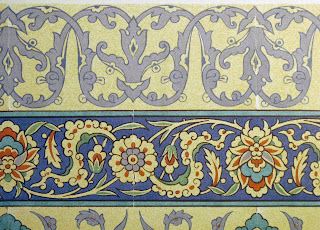You know, I've held this post as a draft for ages now. I was hoping to be able to add something to the text copy, but I'm not going to. I'm just going to show you the images and let you see for yourself their jaw-dropping beauty and technicality.
I had an opportunity to study this set of immaculate original lithographs from 1877, entitled L’Art Arabe d’apres les monuments du Kaire, by Emile Prisse d'Avennes. It's hard to describe the effect of handling original prints that are centuries old. The artist's hand feel so intimately close that they feel as if they are alive.
These gorgeous prints are from the hand of "an artist of consummate skill" according to Mary Norton, writing for Aramco (which is incidentally the Saudi-Arabian Oil Company who's website is an incredible resource of excellent writing), Emile Prisse d’Avennes. He was also "a writer, scientist, scholar, engineer and linguist, a genius who spent much of his life among the illiterate." I like this guy!
Ms. Norton goes on: "Of the hundreds of 19th-century Orientalists – those Western artists, scholars and writers who gravitated to the Islamic world following Napoleon’s invasion of Egypt in 1798 – few possessed so prodigious an intellect, such a trove of talents, so insatiable a curiosity or so passionate a commitment to record the historical and artistic patrimony of ancient Egypt and medieval Islam."
Taschen has recently re-published l'Art Arabe, as this new article in World of Interiors explains.
 |
| The World of Interiors magazine, June 2011 |
These next few are small fragments of the full page lithos, but they give you an excellent sense of the detail and artistry. Stencil designs, anyone?










































